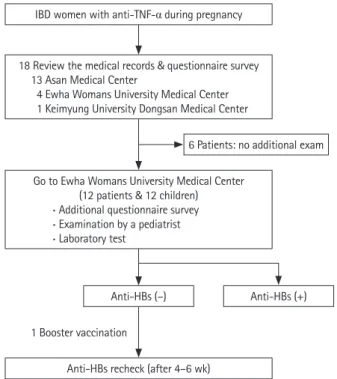ing young age and this period belongs to the reproductive age.
1-3Especially, women IBD patients would experience pregnancy and delivery along with the disease. In addition, as IBD is a chronic disease and patients should receive long-term medi- cal therapies, IBD women would also have to continue medi- cation even during their pregnancies.
In previous studies, pregnant IBD women’s disease activity seemed to affect the pregnancy-related outcomes such as pre- term delivery, miscarriage and normal delivery rate.
4-8For ex- ample, if pregnant IBD women maintained the remission state pISSN 1598-9100 • eISSN 2288-1956
https://doi.org/10.5217/ir.2018.00071 Intest Res 2019;17(2):237-243
Influence of anti-tumor necrosis factor-alpha therapy on pregnant women with inflammatory bowel disease and their children’s immunity
Ko Eun Lee
1, Sung-Ae Jung
1, Sang Hyoung Park
2, Chang Mo Moon
1, So Yeon Shim
3, Eun Soo Kim
4,5, Su Jin Cho
3, Seong-Eun Kim
1, Kwang Bum Cho
4, Suk-Kyun Yang
21
